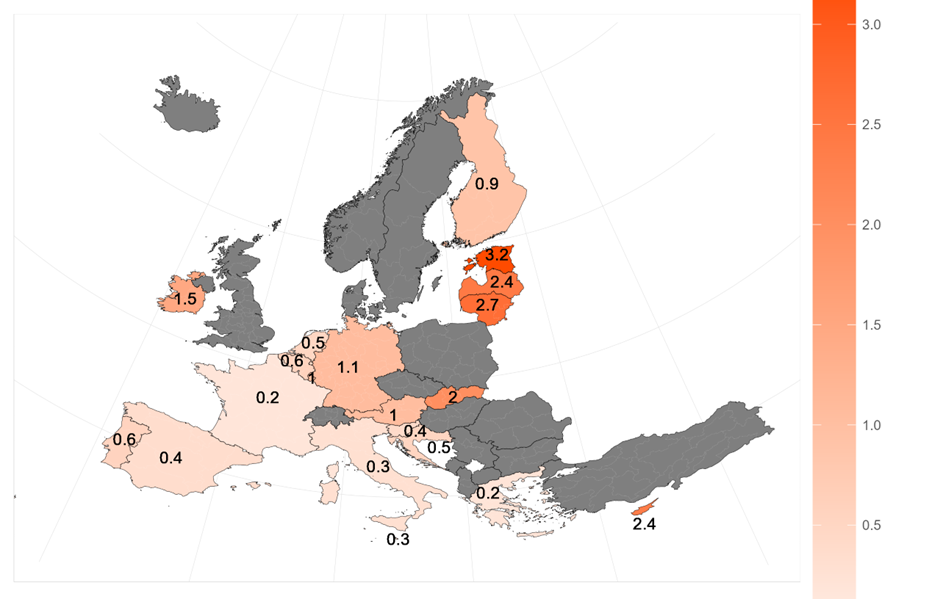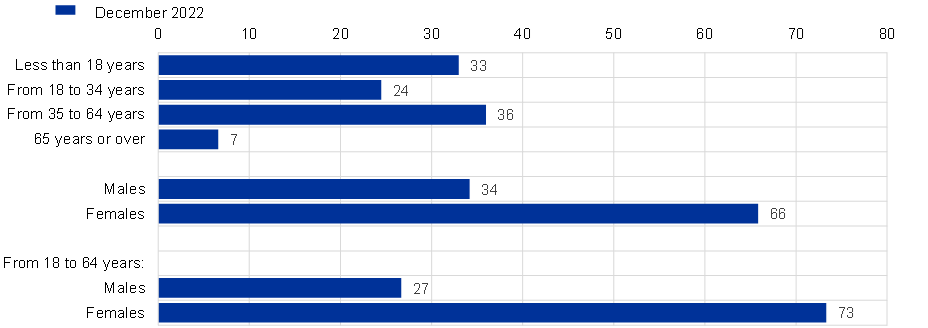- THE ECB BLOG
Integrating Ukrainian refugees into the euro area labour market
1 March 2023
Millions of Ukrainians were displaced by Russia’s unjustified war and have found refuge in the euro area. Many refugees want to work and thus increase the euro area labour force. This ECB Blog post updates previous calculations by considering novel information on the whereabouts and demographics of Ukrainian refugees.
Russia’s unjustified war against Ukraine triggered the largest displacement of European citizens since the Second World War. Nearly 18 million people, or 40% of Ukrainians, are in urgent need of protection and humanitarian assistance and over 6 million persons are internally displaced.[1] According to the United Nations High Commissioner for Refugees (UNHCR) as of 21 February 2023, over eight million people have been recorded as refugees from Ukraine across Europe. For them this means leaving their families and homes behind as well as, in many cases, quitting their jobs. So, amid this tragedy, Ukrainian refugees are looking for new employment.
The European Union proposed to activate the Temporary Protection Directive to offer quick and effective assistance to people fleeing the war, which was swiftly and unanimously adopted in March 2022. These programmes helped to ease the integration of Ukrainian refugees by providing them with a residence permit, access to employment, access to social welfare and medical care, and access to a suitable accommodation or housing.[2]
As of February 2023, more than 4.8 million Ukrainian refugees registered for temporary protection schemes in Europe, including more than 2.1 million in euro area countries. This figure is significant and corresponds to about 0.6% of the euro area population. There is some heterogeneity in the relative number of Ukrainian refugees under temporary protection schemes compared to the population across different euro area countries. However, as Chart 1 shows, the relative share of Ukrainian refugees varies considerably across euro area countries. Geographical proximity to Ukraine stands out as a main factor driving refugee flows, with the population share of Ukrainian refugees being highest in the Baltic region, standing at 3.2% in Estonia, 2.7% in Lithuania, and 2.4% in Latvia. By contrast, it is lower on average in Southern euro area countries, reaching 0.2% in Greece, 0.3% in Malta, and 0.4% in Slovenia.[3] Outside the euro area, more than 1.5 million refugees registered in Poland, which makes it the largest recipient country of Ukrainian refugees in Europe, while almost 0.5 million refugees registered in Czech Republic. Both countries record a population share of Ukrainian refugees above 4%.
Chart 1
Refugees from Ukraine registered for temporary protection in the euro area by country
Share of the population in the fourth quarter of 2021, percentages.

Sources: United Nations High Commissioner for Refugees, Eurostat, and own calculations.
Notes: Statistics compiled mainly from data provided by national authorities. Most countries reported their latest data in February 2023, with the exceptions of France (31 October), Luxembourg (25 October), Greece (6 December), Italy (27 January), and Germany (31 January).
A recent UNHCR survey suggests that about 40%of Ukrainian refugees were either employed or self-employed as of February 2023, corresponding to roughly half of those who had previously worked in Ukraine.[4]
In Estonia, for example, around 55% of the number of working age Ukrainian refugees with temporary protection have already found employment, while in Lithuania this share is roughly 50%.[5] These workers are mainly employed in manufacturing, construction, wholesale and retail trade, accommodation and food services, and administrative services sectors.
By contrast, while in Ireland the population share of Ukrainian refugees stood at 1.3%, only around 20.7% of working-age Ukrainian refugees recorded earnings from employment in January 2023.[6] Of the persons attending public services employment support events in Ireland, 70% noted that the lack of proficiency in the English language was a challenge in securing employment, with key language courses being offered to further help refugees to integrate fully into the Irish labour market.
Another important factor in the integration of Ukrainian refugees is their demographic composition. With martial law still in effect in Ukraine, waves of Ukrainian refugees comprise mostly women and children – see Chart 2. Among the beneficiaries of temporary protection, 33% are children under the age of 18, 60.4% are persons between the ages of 18 and 64, and 6.6% are persons above 65 years. In terms of gender, 34.2% are male and 65.8% are female. However, it should be noted that around half of male refugees are children under the age of 18. Therefore, when considering the working-age population between the ages of 18 and 64, only 26.7% are male and 73.3% are female.
Chart 2
The demographic composition of beneficiaries of temporary protection in the euro area
Percentages

Sources: Eurostat and own calculations.
If all refugees aged between 18 and 64 were able to work, this would suggest that at most 1.3 million refugees (60% of the 2.1 million refugees that registered for temporary protection) could have already started or could start working in the euro area in the short term.[7] This represents around 0.8% of the euro area labour force.
This number, however, needs to be seen as an upper bound. Many Ukrainian refugees are likely to go back to Ukraine after the conclusion of the war. Moreover, the high degree of uncertainty surrounding the future course of the war makes it harder to accurately assess and quantify how many refugees are willing to stay in the euro area permanently. For example, according to a recent German survey, 37 percent of the Ukrainian refugees would like to stay permanently or at least a few years. 34 percent plans to leave after the end of the war.[8]
On top of the support already provided by European countries, displaced refugees would value classes in local languages and support to ensure that their skills are formally recognised. Given the significant share of children under temporary protection, support such as childcare services and schooling would also be important to allow parents to work outside their home.
Taking into account these considerations, an updated estimate on the impact of Ukrainian refugees to the euro area labour market would account for an increase in the labour force by around 0.3% to 0.5% in 2022. However, this impact could further increase in 2023 as the war continues. This would be driven, on the one hand, by a further increase in the number of displaced Ukrainian citizens in need of humanitarian assistance and, on the other hand, by a more successful integration of the current beneficiaries from temporary protection into their host countries.
Subscribe to the ECB blogSee the latest United Nations Ukraine Flash Appeal and the latest International Organization for Migration Ukraine Internal Displacement Report for further details. This information is also summarized in the UNHCR Operational Monthly Updates.
The full set of obligations of EU countries towards persons enjoying temporary protection is provided by the European Commission in this link.
Among the largest euro area countries, the number of Ukrainian refugees under temporary protection schemes reached 1.1% of the population in Germany, 0.2% in France, 0.3% in Italy, 0.4% in Spain, and 0.5% in the Netherlands.
See the UNHCR document titled “Lives on Hold: Intentions and Perspectives of Refugees from Ukraine #3” for further details.
Roughly half of Ukrainian refugees started working in the wholesale and retail trade, transport and warehousing, and accommodation and food services sectors.See “Arrivals from Ukraine in Ireland Series 9”.
This figure is aligned with the upper bound of previous ECB calculations. See the ECB Economic Bulletin Box, “The impact of the influx of Ukrainian refugees on the euro area labour force”. Consistently, more recent OECD calculations in their article titled “The potential contribution of Ukrainian refugees to the labour force in European host countries” suggest that despite the high uncertainty, the labour force could increase by 0.5% by the end of 2022 for all European countries together.
See “Kurzstudie: Geflüchtete aus der Ukraine in Deutschland” for further details.




